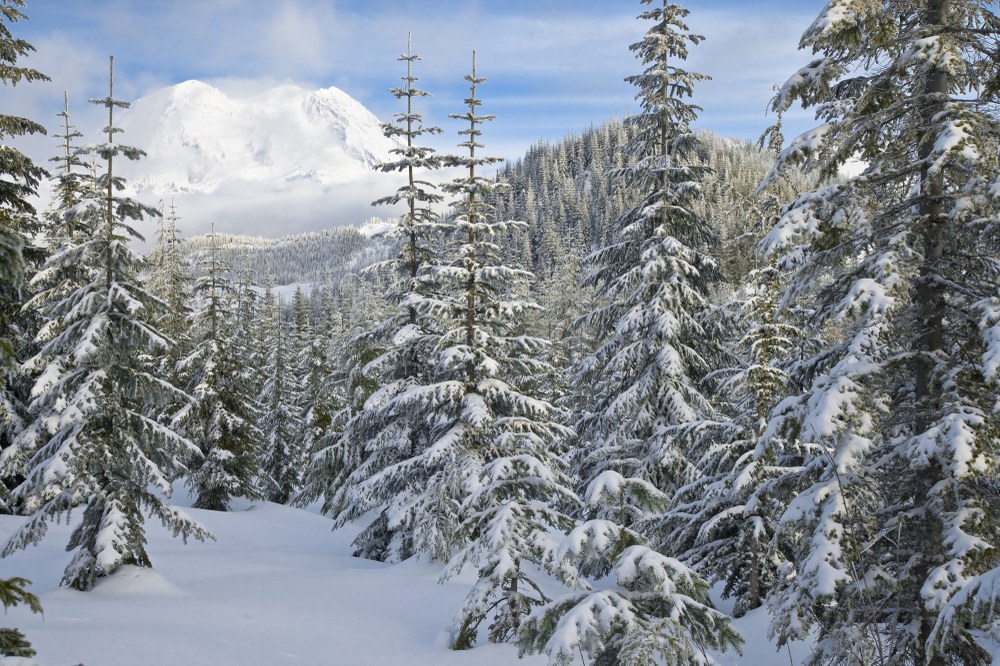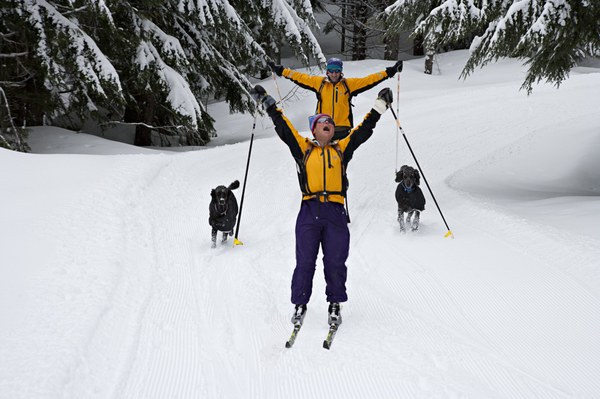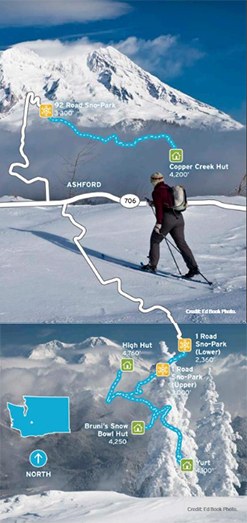
I’m not going to sugarcoat this for you. It’s a hard trek during winter. My best friend and I took on the challenge last spring, breaking trail for a full mile through fresh powder with heavy backpacks. We felt breathless as we snowshoed four miles to one of the highest points in Tahoma State Forest. But with every crunch beneath our snowshoes — and between the sounds of our groans - the top of Mount Rainier became more and more visible.
When the trail finally flattened,we were surrounded by 360-degree views. Despite our exhaustion, smiles crept into the corners of our mouths growing broadly until we were gaping at the mountain. Even better, we were now standing in front of High Hut, a hidden gem offering guests a comfortable place to rest — and revel — during Washington’s dark winters.
We went inside, slung our backpacks onto bunkbeds, and put on dry socks to relax in awe of Mount Rainier’s full majesty stretching before us.
Building a hut system
On a winter day in 1989, Bob Brown’s mind was wandering as he explored Mount Rainier’s Paradise area during a backcountry ski. A Washington State Department of Natural Resources (DNR) forest manager, Bob had recently read about hut-to-hut skiing trail systems. European-inspired, hut-based backcountry skiing took off in America nearly a century before his trip that day, and while hut systems were available in Eastern Washington, none had been built on the western side of the Cascades. Not yet that is.
“I thought, gee, [a hut system] would be sort of neat [in Western Washington]. And then I thought, gee, all the roads – on both the DNR land and private timber company land, and even some forest service land – are all snow covered in the winter. So there’s ready-made trail. And you have landings, which are cleared areas, where you can build huts on and they would have views.”
Bob called a meeting between DNR, Washington State Parks, and the Forest Service about opening a new hut-to-hut skiing trail in the Tahoma State Forests. They sent out 1,500 questionnaires to measure public interest. Only two people didn’t like the idea.
The group established Mount Tahoma Trail Association (MTTA) in 1989 as a nonprofit and started fundraising. The state gave $160,000 — money pitched by a state senator who later said the funds were the best he’s ever allocated because of how well they were used. Other contributions came from grassroots fundraising efforts and in-kind workhours by volunteers.
By fall, MTTA was working on building the High Hut. Its completion in 1990 was followed by Snow Bowl Hut, Copper Creek Hut, and The Yurt in 1991. For three decades, volunteers donated more than 4,000 hours every year to operate and maintain the huts and trails, doing everything from work parties to weekend ski patrols. This allows MTTA to be a 100% volunteer-run organization, which means every penny donated or raised goes directly back into operating the facilities.
“If you come up with a good idea, then there’s a chance it might turn into something. But the [credit goes to] all the talented people who get excited about this thing and pour their heart and soul into it and make it work,” Bob said.
‘Ready-made’ trails in our working forests
When you ski or snowshoe from the lower sno-park near Ashford, it’s not long before a sign welcomes you into in the heart of a working forest. As part of Washington’s three million acres of federally-granted state trust lands, Tahoma State Forests are managed by the Washington DNR and are legally obligated to provide an array of benefits to Washington residents. Priority is placed on perpetually generating revenue to support public institutions, like funding construction of schools, namely through timber harvests.
Timber harvesting techniques have come a long way over the last century, which had previously left this land nearly barren. DNR and partnering conservation groups have worked together to revitalize the area, returning it to a resilient, productive working forest to sustain healthy and diverse habitats.
“When Snow Bowl Hut was built, there was a big open clear cut in front of it, and people would ski in that clear cut…and you can’t ski in the clear cut anymore,” Bob said. “And the reason you can’t ski in that clear cut is because there’s too many trees.”
When the season turns to winter, logging truck roads go dormant in the snow. Utilizing these existing roads for recreation preserves nearby conservation areas while also offering a backcountry experience. The trail system also evolves and changes with timber production and forest growth. That’s why the trails fluctuate between 50 and 75 miles of terrain from season to season.
“I’m proud that my agency and our partners are able to manage the public’s lands in ways that protect our natural resources, provide millions of dollars for public services, and give us some of the most beautiful areas to explore,” said Commissioner of Public Lands Hilary Franz, a skier who manages DNR. “The Tahoma State Forests are a great example of what our working forests can do for us, from timber harvests to recreational opportunities.”
Accessible and affordable
More than 100,000 people have stayed overnight at the huts since their inception in the 1990s, not counting the thousands of day users who’ve skied through the forest. But many still consider this trail system to be among Western Washington’s best kept secrets. Most people find out about it through word of mouth and the MTTA Communications Director was no exception. Like many of the organization’s 90 volunteers, Heath Jones was inspired by his first trip up to the huts to give back. He volunteered on ski patrol for several years, and now focuses on creating awareness and accessibility for both summer and winter users.
“Making it accessible is important, and making it fun for all ages, whether playing board games or having bachelor or bachelorette parties or things like that… getting more people to understand what the huts are capable of… I think is a huge,” Heath said.
For MTTA, accessibility means providing ongoing improvements to enhance experiences for all skill levels, and that includes adding to the trail system. As the forests and trails evolve, so do the huts. For example: once powered by screw-on propane bottles, the huts now run on solar.
These upgrades, intersecting with convenience and safety, are met with respect by the users who practice Leave No Trace principles.
“People come up and take a sense of pride in it,” Jones said. “They keep it pretty clean, refill water, sweep up, and leave it for the next people, which is important because they’re all public use. From what I’ve seen people are pretty respectful of the property and the ability to go up and enjoy the view.”
MTTA doesn’t charge day users a fee. But because the hut system runs on state lands, users must have a Discover Pass and Sno-Park Permit. For overnighters, it’s a $15 charge per person. Bob and Heath both agree that what really sets these huts apart from others in the United States is they are relatively affordable for everyone.
A community gathering place
Gliding from 4,700-feet overlooking the hilly, snow-dusted treeline of Nisqually Valley gave Rachel Sadri — a Mountaineers ski instructor who’s skied for 13 years — some of the best powder she’s ever seen. “It’s the best place you can be. It’s just gorgeous.”
And that wasn’t even the best part.
“Skiing down, when the snow is good, is fantastic, but I do think hanging out with friends and being able to enjoy each other’s company, playing cards, relaxing, and exploring… that’s probably my favorite.”
Rachel isn’t alone in her love for the huts. My first trip would not be my last, and I’m willing to bet you’ll feel the same way while exploring this recreational gem 30-years in the making. So let this be my word-of-mouth to Mountaineer readers: go there. Mt. Rainier is waiting, and remember to bring an extra pair of socks.

Planning a Visit? What to Know:
Hut Amenities
Each hut provides a stovetop, pots to melt snow for water, bunk beds, kitchen essentials, a fireplace, and an outside bathroom.
What to Bring
Bring the Ten Essentials! Don't forget your Discover Pass and sno-park permit.
Etiquette
Snowshoers should stay to the side to preserve the groomed trails for skiers. You may be sharing the huts with other groups, so be respectful and practice Leave No Trace principles.
Reservations
The huts are free to use from 7am-7pm. An annual gala is held every November, which includes a lottery for first-round reservations. Beginning in late-November, the website opens all remaining spots for reservation. The huts are always full on weekends, but weekdays often have openings, and you can check back regularly for weekend cancellations. For more information, visit skimtta.org.
High Hut
- Elevation: 4,760 feet
- Gain: 2,400 feet
- Miles to hut: 4
- Sleeping capacity: 8 people
Snow Bowl
- Elevation: 4,250 feet
- Gain: 2,000 feet
- Miles to hut: 4
- Sleeping capacity: 14 people
Copper Creek
- Elevation: 4,200 feet
- Gain: 2,400 feet
- Miles: 4
- Sleeping capacity: 14 people
The Yurt
- Elevation: 4,100 feet
- Gain: 1,740 feet
- Miles to hut: 6.5
- Sleeping capacity: 6 people

Images by Ed Book Photo.
This article originally appeared in our Winter 2019 issue of Mountaineer Magazine. To view the original article in magazine form and read more stories from our publication, click here.
 Ashli Blow
Ashli Blow